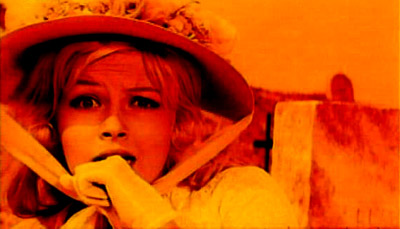
LIMONÁDOVÝ JOE ANEB KOŇSKÁ OPERA
(Lemonade Joe, Cecoslovacchia/1964) R.: Oldřich Lipský. D.: 86'
[Lemonade Joe o l'opera del West]. T . int: Lemonade Joe. Sog.: dall'opera teatrale omonima di Jiří Brdečka. Scen.: Jiří Brdečka, Oldřich Lipský. F.: Vladimír Novotný. M.: Miroslav Hájek. Scgf.: Karel Škvor. Mus.: Jan Rychlík, Vlastimil Hála. Su.: Josef Vlček. Int.: Karel Fiala (Lemonade Joe), Rudolf Deyl (Doug Badman), Miloš Kopecký (Horác Badman alias Hogofogo), Květa Fialová (Tornado Lou), Olga Schoberová (Winnifred Goodman), Bohuš Záhorský (Ezra Goodman), Josef Hlinomaz (Grimpo), Karel Effa (Pancho Kid), Waldemar Matuška (Banjo Kid), Eman Fiala (pianista), Vladimír Menšik (primo barman), Jiří Lír (secondo barman), Jiří Steimar (Kolalok). Prod.: Filmové studio Barrandov. Pri. pro.: 16 ottobre 1964. 35mm. D.: 86'. Col. Versione ceca con sottotitoli inglesi / Czech version with English subtitles
Da: Národní filmový archiv
Il cammino che portò l'eroe di Lemonade Joe sul grande schermo è stato tortuoso, ma l'attesa è stata ben ripagata: questa singolare parodia letteraria del genere western è stata adattata al cinema in maniera eccellente. Anche se le prime reazioni della critica nazionale non furono unanimi, all'estero il film fu accolto bene e decenni dopo è diventato uno dei titoli più popolari e criticamente apprezzati della cinematografia cecoslovacca.
Le vicende del bel cowboy che all'alcol preferisce la limonata e si batte con successo contro il crimine erano un'invenzione dello scrittore Jirí Brdecka. Appassionato di storie d'avventura, Brdecka aveva cominciato a pubblicare la sua serie umoristica già nel 1940, e alla fine della guerra la portò sul palcoscenico. Le avventure di Joe ispirarono inoltre il cortometraggio di animazione di Jirí Trnka Arie prerie (1949) e Brdecka stesso le adattò per la radio e poi ancora per il teatro: il film si basa proprio sull'allestimento teatrale del 1955.
Dato l'esotismo delle ambientazioni, il regista Oldrich Lipský prese in considerazione una coproduzione con la Jugoslavia, ma poi il set della cittadina del West fu costruito nei Barrandov Studios, per gli esterni rocciosi si ripiegò sui dintorni di Praga e gli effetti visivi fecero il resto. Il film fu girato in widescreen, ma l'uso della colorazione, del movimento accelerato e di tecnologie obsolete (come gli sfondi proiettati e le doppie esposizioni) richiamano il cinema muto. Alle scene con i personaggi in carne e ossa si accompagnano qua e là le animazioni di Jirí Trnka. I dialoghi sono improntati a una parodia esagerata ma raffinata, e alcune memorabili espressioni sono poi entrate nel linguaggio di tutti i giorni. La popolarità e l'importanza di Lemonade Joe è testimoniata dal suo ritorno nelle sale cecoslovacche nel 1984 e dalla monografia del Národní filmový archiv che gli è stata dedicata alla fine degli anni Ottanta.
Tomáš Hála
The road of the hero of Lemonade Joe on cinema screens was a tortuous one. But eventually the waiting paid off. This unique literary parody of Wild West stories has at last earned an excellent film adap- tation. At the time of its premiere, Czech critics were not unanimous, but abroad it received positive attention. Decades later, it became one of the most popular films of Czechoslovak cinema, finally appreciated by contemporary scholars.
The mind behind the stories of a handsome cowboy who prefers lemonade to alcohol and is more successful than others at fighting crime was that of writer Jirí Brdecka. An admirer of adventure stories, he started publishing his humorous serial already in 1940, and at the end of the war, he adapted it into a theater play. He also inspired Jirí Trnka's short puppet film Arie prerie (1949). Brdecka modified Joe and his adventures for the radio and again for the theater. The 1955 production of the play became a foundation for the feature-length film version.
Because of the exoticism of the required locations, director Oldrich Lipský considered undertaking a co-production with the then Yugoslavia. But in the end, the sets for the little Western town were built on the Barrandov Studio lot, and the rocky outdoor locations were found near Prague. The rest was taken care of by visual effects. The film was shot in widescreen, but its poetics recalled silent cinema (tinting and accelerated movement in some scenes) as well as some obsolete technologies (background projection and double exposures). Live-action scenes were occasionally combined with animations by Jirí Trnka.
An exaggerated but tasteful parody was evident in the dialogue, and certain expressions from the film even entered everyday popular speech. The popularity and importance of this film is testified by its renewed premiere in Czechoslovak cinemas in 1984 as well as a volume dedicated to the film by the National Film Archive at the end of the 1980s.
Tomáš Hála

Tariffe:
Aria condizionata
Accesso disabili
Tel. 051 522285











